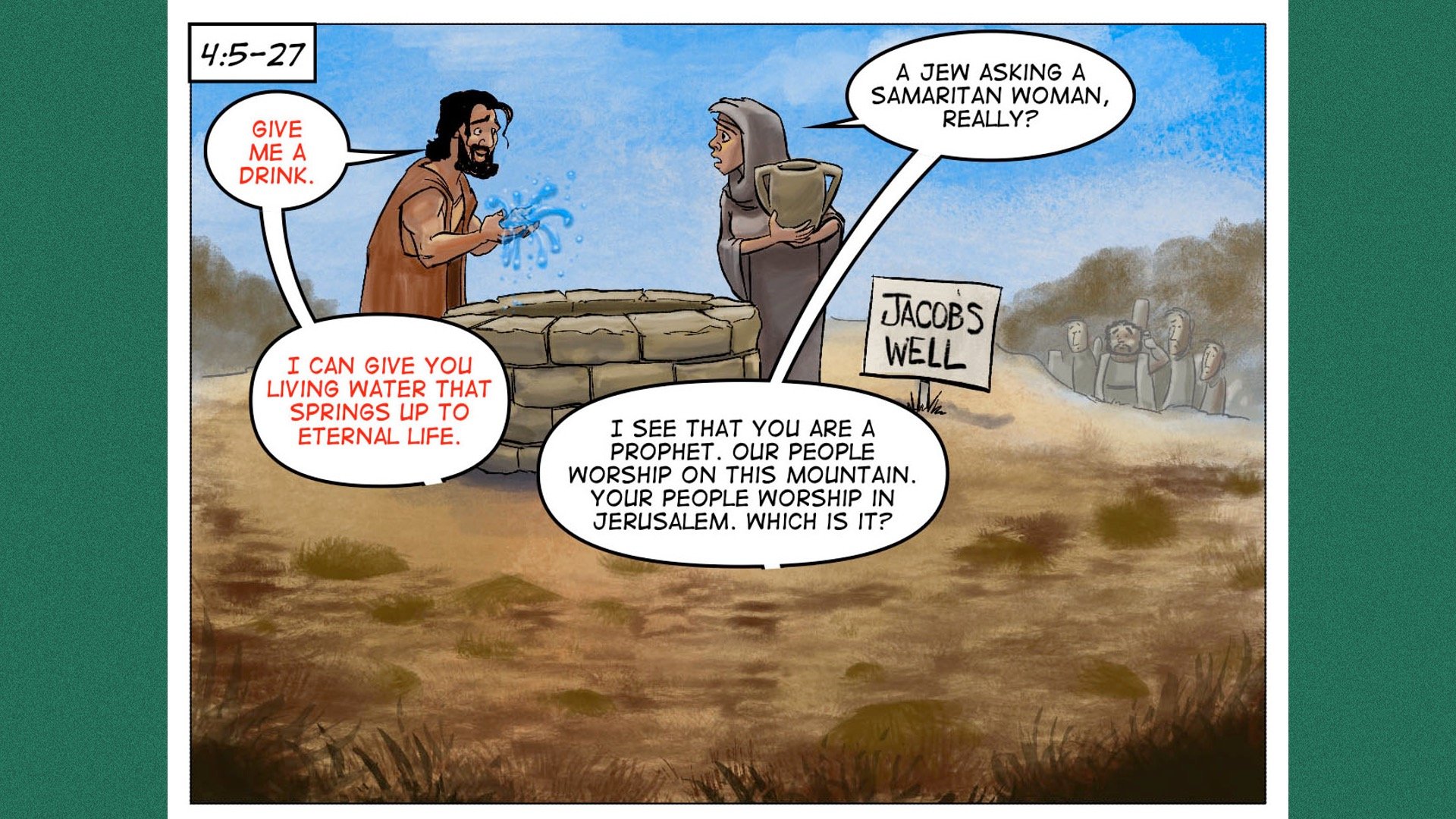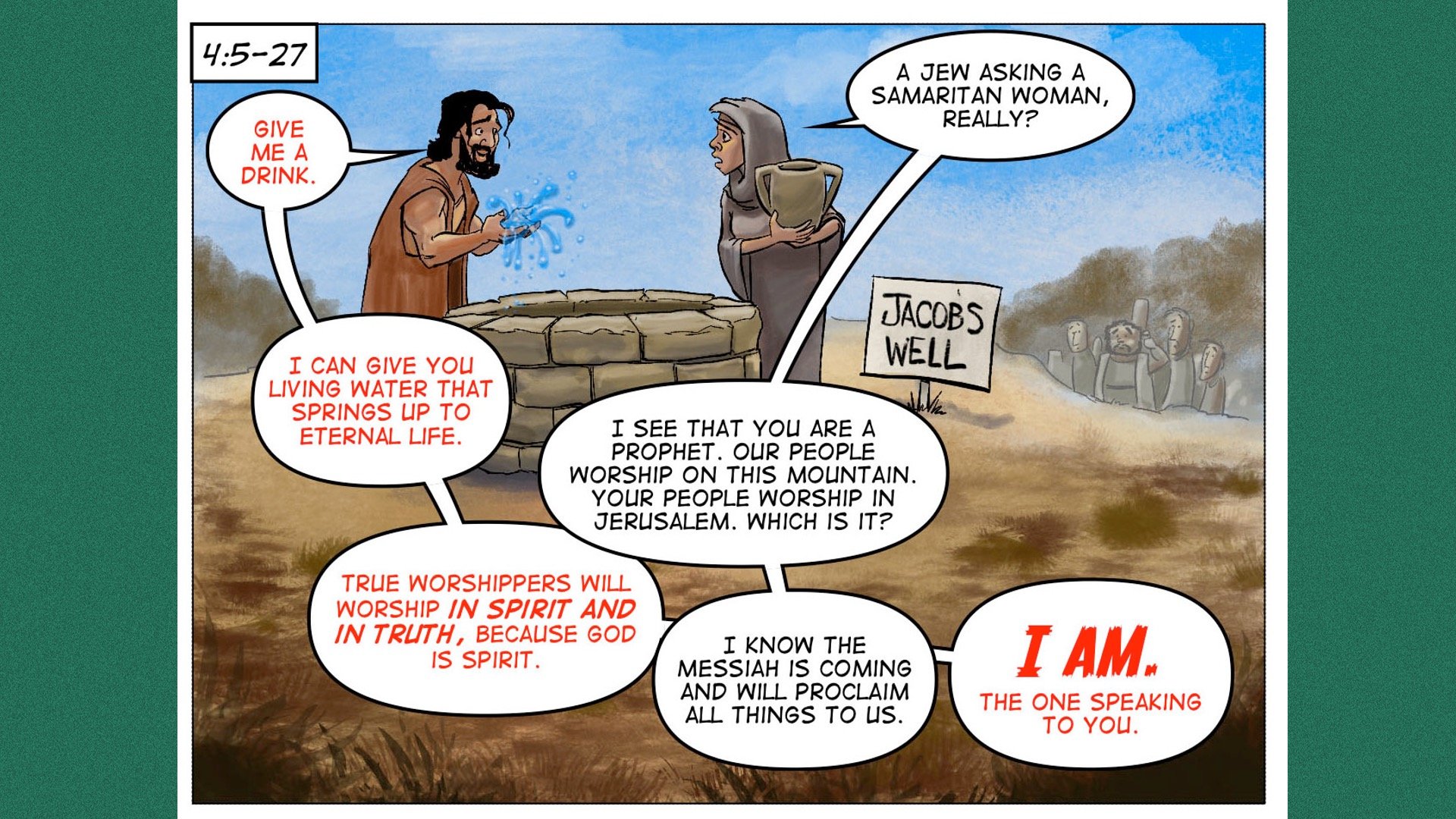A Man in the Dark, A Woman in the Light
A Man in the Dark, A Woman in the Light
This is the story of Jesus’ conversation with a Samaritan woman at Jacob’s well. The story stands in stark contrast to the conversation Jesus had with a religious leader named Nicodemus in John 3:1-21.
Jesus traveled through Samaria on his way to Galilee. The Jewish people–who lived in Judea to the south and Galilee to the north–despised the people of Samaria. This was a 700-year feud.
The rivalry started in 1 Kings 12 when Jeroboam rebelled against King Rehoboam. Ten of the twelve tribes of Israel seceded from the united kingdom, thus splitting the children of Israel into two kingdoms. The capital of the rebels was Samaria. The Samaritans of Jesus day are descendants of those people.
The Gospel of John uses contrast as one of its major literary devices. The story of Jesus’ conversation with the Samaritan woman is designed to stand in contrast with his conversation with Nicodemus in John 3:1-21. The following contrasts expose the heart of the good news of Jesus’ message.
First century Palestine was a patriarchal society. In this story a woman sees who Jesus is, trusts him, and shares the good news with her entire village, while a powerful man remains befuddled. This contrast demonstrates that Jesus’ message elevates women to equal status with men.
NAMED (NICODEMUS) vs NO NAME
There are two possible reasons why the man is named and the woman is not. First, Nicodemus shows up later in the story and defends Jesus (John7:45-52), thus needed to be identified. Second, while Nicodemus represents a particular person, the woman represents the world. She represents all the “outsiders” that the religious elite hated and that God loves. Being unnamed makes her a universal figure.
RELIGIOUS LEADER vs RELIGIOUS OUTSIDER
Jesus breaks down the insider vs. outsider dichotomy upon which most religious systems are constructed. The good news of Jesus’ message is for all people.
IN THE DARK vs IN THE LIGHT
The setting of each scene in John matters. Things that happen in Galilee tend toward the positive message. Things that happen in Jerusalem expose the darkness and blindness of the religious establishment. Here it is obvious that the religious leader is in the dark and the religious outsider stands in the light.
Further, Jesus said at the end of his conversation with Nicodemus,
For all who do evil hate the light and do not come to the light, so that their deeds may not be exposed. But those who do what is true come to the light, so that it may be clearly seen that their deeds have been done in God. (John 3:20–21 NRSV)
The woman was willing to be honest with Jesus about who she was and was open to receive something from him. She stood in the light.
CONVERSATION ABOUT FAITH vs FAITH EMBODIED
Like so many religious leaders and scholars, Nicodemus wanted to talk about proper doctrine and the faith. The woman trusted Jesus and acted on it. She quickly proclaimed what she had seen to her people.
GOD LOVES THE WORLD vs SHE IS THE WORLD
Jesus told Nicodemus that God loves the world in John 3:16. The world means all the people outside of the religious elites’ inner circle of God-loves-only-us club. The woman demonstrates to the reader who Jesus meant by the world. It includes all people, even a woman from Samaria.
Now, let’s turn our attention to the story itself and learn more about the message of Jesus.
Jesus uses many metaphors in John to describe who he is and the purpose of his mission. Here he claims to offer living water. His words echo Isaiah’s vision,
“Ho, everyone who thirsts, come to the waters; and you that have no money, come, buy and eat! Come, buy wine and milk without money and without price. Why do you spend your money for that which is not bread, and your labor for that which does not satisfy? Listen carefully to me, and eat what is good, and delight yourselves in rich food. Incline your ear, and come to me; listen, so that you may live. I will make with you an everlasting covenant, my steadfast, sure love for David.” (Isaiah 55:1–3, NRSV)
The conversation about the woman’s marital status serves two purposes in the story. First, it shows that she is most likely a childless widow. The Law of Moses made provision for a widow, that if her husband died before she had a child, his brother was obligated to marry her and produce a child for him (see Deuteronomy 25:5-10). This woman has lived a worst case scenario. All the brothers died, she is still childless, and now she finds refuge in the home of a man who is not a relative. In her culture, she was at the bottom of the social ladder, only slightly higher than a leper.
Second, the fact that Jesus knows this information about her reveals that he is not an ordinary man. She recognizes that he is at least a prophet.
She takes advantage of her private audience with a man of God and asks her burning theological question…
WHERE SHOULD WE WORSHIP?
When Jeroboam severed Israel from Judah he cut the people off from their center of worship: The Temple. He quickly established two high places where he erected golden calves. Over the next 700 years the people in that region experienced two significant theological shifts.
First, they infused Canaanite religion into their Judaism. Second, they were conquered by the Assyrian Empire. The Assyrians intermarried them with other cultures, thus diluting any chance of maintaining a pure Jewish bloodline.
Jesus surprises the woman and reader with his response. The question of where we should worship is not important. The question is…
WHO SHOULD WE WORSHIP?
The climax and conclusion of this dialogue is that Jesus boldly claims to be the Messiah. He is the one who will reveal God’s true kingdom to the world.
He reveals that the real question regarding worship, and the thing that unifies us all is the how we worship: in spirit and in truth.
The Samaritan woman becomes the first evangelist. She simply proclaims, “Come and see!” She leads the people of her village to encounter Jesus for themselves.
Jesus’ disciples show up to remind the reader of three things:
how shocking this conversation is in his cultural context.
how the disciples are on a slow trajectory of being able to see Jesus for who he is. They still don’t get it.
how Jesus ministry is about offering water and bread to all people, not just the Jews.
The faithful testimony of this Samaritan woman led to the transformation and salvation of an entire village.
Jesus has come to save the world, that means EVERYBODY!



